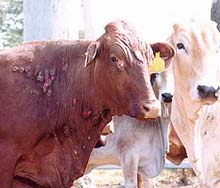Counting the cost of worms in cattle

CSIRO Livestock Industries scientists in Rockhampton have observed larger-than-expected numbers of a parasitic nematode in the gut of insects responsible for transmitting them – buffalo flies.
The ’filarial’ nematode (Stephanofilaria sp)- one of a group of worms transmitted by insects, and which live in the blood and tissues of their animal or human hosts – has been found in around 50 per cent of female buffalo flies in northern Australia.
The discovery could have implications for the control of both the nematode and the buffalo fly, leading to improved livestock welfare and production potential and reduced hide damage caused by fly bites and nematode activity.
“For such a large percentage of insect vectors to be infected is highly unusual,” says CSIRO Livestock Industries researcher, Dr Ian Sutherland.
“By comparison, around one per cent of tsetse flies may be infected with the parasite that causes sleeping sickness and which afflicts millions of people in Africa. And very few mosquitoes are found to contain the malaria parasite at any given time. It seems a reasonable assumption then, that there must be a huge number of worms available to the buffalo flies.”
According to Dr Sutherland, when infected buffalo flies feed on the blood of cattle, infective larvae are transmitted from the insects’ salivary glands to beneath the animals’ skin. From there they move into lymph nodes and mature to adults. The parasites then produce thousands of ’microfilaria’, which live in the capillary beds of the skin, where they are ingested by other buffalo flies.
Dr Sutherland’s team has observed a significant inflammatory reaction around these microfilaria and is investigating the role of the parasite in instigating this reaction.
“The immune response to infection is a drain on available energy and can divert resources from growth and reproductive success,” Dr Sutherland says.
“So it’s important to understand their effect on the animals’ well-being and production efficiency and, if significant, devise suitable control methods.”
Such controls would also benefit Australia’s valuable hide export industry. Early research suggests that control measures could be targeted at the buffalo fly. ’The nematodes don’t develop fully in male flies, so only female flies transmit the parasite,’ Dr Sutherland says. ’If we can understand the mechanism behind this, we may be able to develop a control method that takes advantage of this quirk of biology.’
More information:
Dr Ian Sutherland, CSIRO Livestock Industries, 07 4923 8187
Media Contact
More Information:
http://www.csiro.au/index.asp?type=mediaRelease&id=PrWormsAll latest news from the category: Agricultural and Forestry Science
Newest articles

A universal framework for spatial biology
SpatialData is a freely accessible tool to unify and integrate data from different omics technologies accounting for spatial information, which can provide holistic insights into health and disease. Biological processes…

How complex biological processes arise
A $20 million grant from the U.S. National Science Foundation (NSF) will support the establishment and operation of the National Synthesis Center for Emergence in the Molecular and Cellular Sciences (NCEMS) at…

Airborne single-photon lidar system achieves high-resolution 3D imaging
Compact, low-power system opens doors for photon-efficient drone and satellite-based environmental monitoring and mapping. Researchers have developed a compact and lightweight single-photon airborne lidar system that can acquire high-resolution 3D…





















